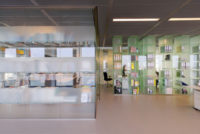The Netherlands’ obsessive relationship with water dates to the construction of the first polders in the Middle Ages. But only in recent decades have Dutch designers and engineers considered coexisting with water, rather than holding it back. The Rijswijk-based architecture firm Waterstudio, for example, has gained prominence as visionary designers of floating homes both locally and as far afield as Dubai, while organizations like the Royal Institute of Dutch Architects has sponsored resources including “H2olland,” an online exhibition that explores new opportunities for a life afloat.

Architects Maxim Winkelaar and Bob Ronday won a competition sponsored by the Bosch Architecture Initiative and the Dutch Union of Architects to design a component of the Watertuinen development. It includes an artificial lake filled to a depth of 14 feet with diverted rain and river water. Ronday and Winkelaar proposed constructing a weighty 1,550-square-foot concrete box that displaces lake water to a depth of five feet, creating a “hole” that nevertheless floats on the lake and provides a surface on which houses can be constructed.


This counter-trend to land reclamation is manifest less dramatically in De Groote Wielen, located near Den Bosch about halfway between Amsterdam and Maastricht. There, a new 4,300-unit residential development called Watertuinen will include an artificial lake filled to a depth of 14 feet with diverted rain and river water. In addition to creating shorefront for Den Bosch’s most desirable housing, the project includes 40 houses partially submerged into the lake itself. Although construction has yet to begin, these so-called “Waterholes” are proving popular: the waiting list has topped 200 people.
Waterholes are not to be confused with houseboats bobbing on the lake’s surface, says Maxim Winkelaar, who, with Bob Ronday, won the competition sponsored by the Bosch Architecture Initiative and the Dutch Union of Architects to design this component of the development. Ronday and Winkelaar proposed constructing a weighty 1,550-square-foot concrete box that displaces lake water to a depth of five feet, creating a “hole” that nevertheless floats on the lake. The young duo is now forming an atelier to realize its scheme.
When completed, the concrete box will serve as the house lot into which a slimmer two-story dwelling volume is inserted. Clad in cedar planks and glass, its ground-floor bedrooms and baths and surrounding yard will be mostly hidden by the box’s concrete walls. The kitchen and public rooms upstairs will float slightly above the water line, with an adjacent terrace that can serve as a boat dock; the rooftop will offer additional outdoor living space. Winkelaar explains that sewage and electricity-grid connections will be housed in flexible, waterproof piping that divers will secure into place, and that there are plans to include graywater recycling to flush the toilets.
The Den Bosch town council “wanted to make an attraction,” Winkelaar says, “and to make a point about what’s possible.” To this end, the Waterhole concept can be adapted to a wide variety of conditions. “In Holland you’ve got a lot of rivers that run very high in the winter, and very low in the summer. So in the summer we have all this extra land we don’t really use.” With some fiddling, Waterholes could conceivably settle or float according to the season—or, should Dutch and other waterfront communities lose the fight against rising sea levels, these attractions could become commonplace worldwide.





Post a comment to this article
Report Abusive Comment